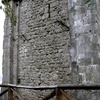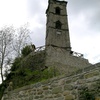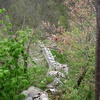Castle of Gorfigliano
Gorfigliano castle was built in correspondence with a curtis, or demesne, dependent on the Lucchese monastery of Domini et Salvatoris before 997, the year of the first mention of the Castello de Corfiliano. Initially assigned to several members of the noble Cunemondinghi family, in 1026, it passed to Moretto of the Suffredinghi, whose potentate was centred in Anchiano.
Castle Gorfigliano consisted of a large polygonal enclosure that, following the natural terrain, encircled a small hill. The main element of the fort is the square-based tower (keep) on the summit of the hill, offset from the centre of the fort itself. Conserved are large sections of the walls along with the remains of the two circular towers, found after excavations and the keep tower, which was transformed into a bell-tower in the 18th century.
In the village there is also the Church of Saints Giusto and Clemente, which houses a Madonna del Rosario on canvas and a wooden statue of a Bishop Saint of the 13th-14th century.
It seems that this fortification did not suffer significant damage during the wars conducted by the city of Lucca for the conquest of the county and so, apparently, life in the castle settlement proceeded relatively peacefully compared with many other military posts in the upper Serchio valley.
Castrum Corfiliani is also mentioned in the Golden Bull of Emperor Charles of Bohemia, as extended in 1376, among the strongholds placed under the rule of Lucca.
In the first half of the 15th century, Gorfigliano, like other towns in the Garfagnana region and the valley of Val di Lima, fell under the domination of Florence and only in 1433, following the peace offered by Ferrara and promoted by Marquis Nicolò, the Lucchese citizens were able to return their properties.
The village was abandoned only in the first decades of the 20th century, after the earthquake of 1920.











